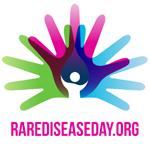Today is World Rare Disease Day. Unlike a typical holiday, the namesake of this occasion is anything but good or happy.
Yet as a Taylor’s Tale volunteer, I have learned that this day is a celebration of goodness and hope. It is a celebration of the millions of dedicated people who comprise the rare disease community….the healthcare providers, researchers, caregivers, families, and most importantly, the rare disease patients who bravely face each day with a steadfast commitment to see a better tomorrow.
United with our supporters and advocates, we are most definitely individual and collective forces for good.
What is World Rare Disease Day?
Founded by Eurordis in 2008 and brought to the United States by the National Organization for Rare Disorders the following year, Rare Disease Day unites patient organizations from around the world that work hard year-round to raise public awareness of and funding for rare diseases. It is a day of special events for very special people.
This day also provides a targeted opportunity to educate elected officials and other public policy makers, industry leaders, researchers and healthcare professionals about the dire impact that rare diseases have on the lives of patients and their families.
Rare Disease is a global public health imperative.
The numbers are overwhelming: worldwide, an estimated 350 million people live with a rare disease. In the United States, one in 10 people suffer from one of at least 7,000 rare diseases, some with devastating consequences.
The reality is clear: rare diseases are not so rare after all. Nor do rare diseases recognize geopolitical borders. Rare diseases represent an equal-opportunity destructive force that is shared by humanity.
Even small organizations like Taylor’s Tale are key to this global call-to-action. We participated in a consortium with other patient organizations in the United States and Ireland to raise funds in support of gene therapy research at the University of North Carolina. And, an international collaboration of scientists conducted the research.
Rare disease progress comes day by day.
While we may only recognize World Rare Disease Day once a year, progress continues on behalf of rare disease patients due to the hard work conducted every day by their advocates and caregivers.
Just a few weeks ago, Abeona Therapeutics announced that the Food and Drug Administration granted crucial Orphan Drug Designation to the gene therapy treatment for infantile Batten disease that Taylor’s Tale helped fund at the University of North Carolina. The Orphan Drug Designation helps accelerate the timeline for conducting human clinical trials while maintaining the standards that protect patients.
Taylor’s Tale founders Sharon King and Laura King Edwards were cited by the Batten Disease Support and Research Association (BDSRA) for their contributions in advancing this vital research.
Rare disease patients need our attention every day.
Like most special-designation days, World Rare Disease Day is intended to highlight our particular cause. The day serves to galvanize our community and, hopefully, to attract much-needed attention to the public health imperative of rare disease.
On this day, we will acknowledge our steps toward progress in providing viable treatments for rare diseases. We will re-commit to advocating for public policies that improve the quality of life for patients and their loved ones. And we will agree to keep fighting, because we must.
You can help this work by remembering that rare disease is not one day a year…it’s every day, every year for those whose lives are forever changed by a devastating diagnosis like Batten disease.
You can help us spread the word that attention must be paid, and that every life touched by a rare disease…regardless of where in the world…matters. You can join us to be a force for good for all rare disease patients.
Photo courtesy of Viriya Riyakum/Shutterstock.com


